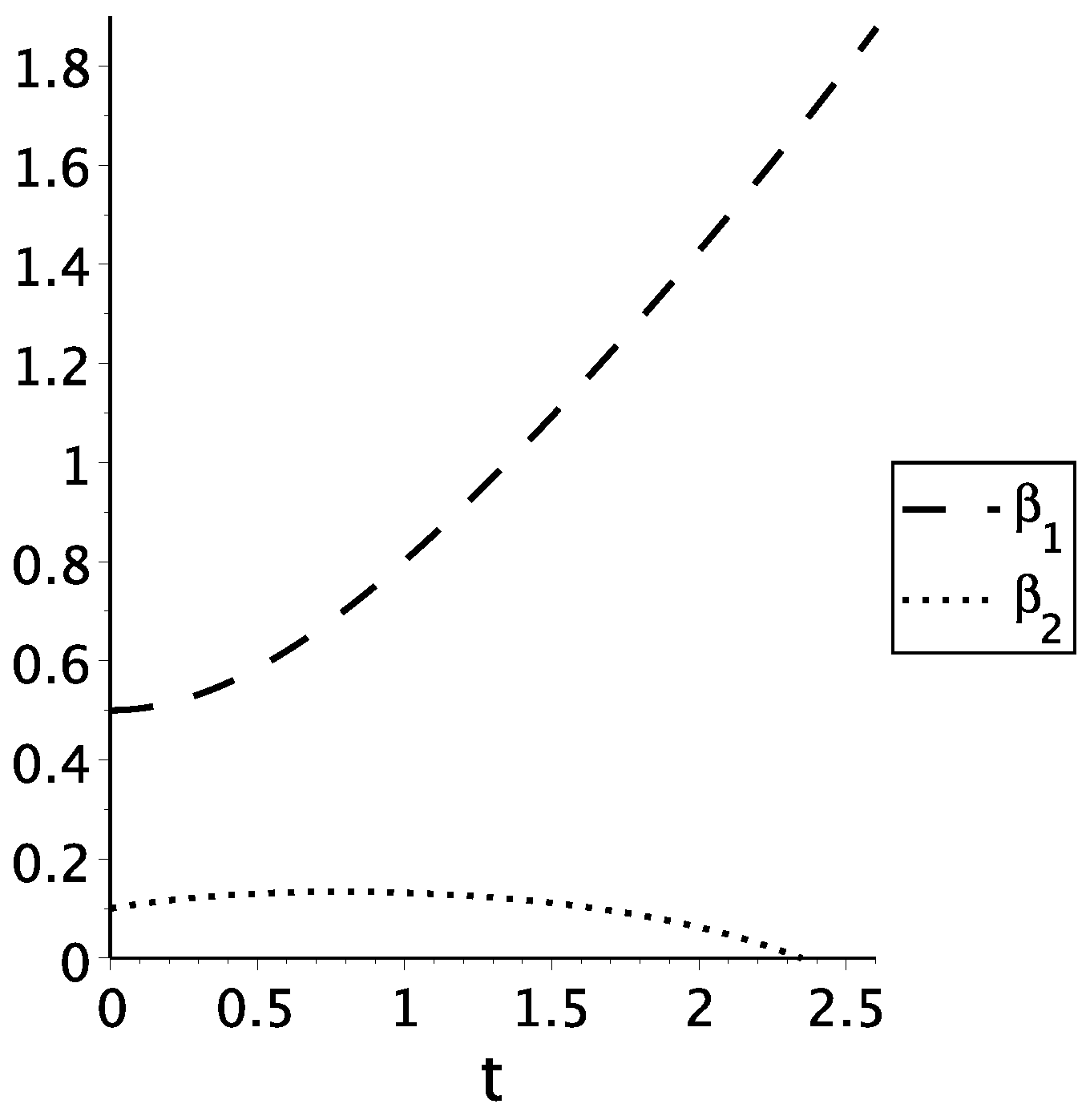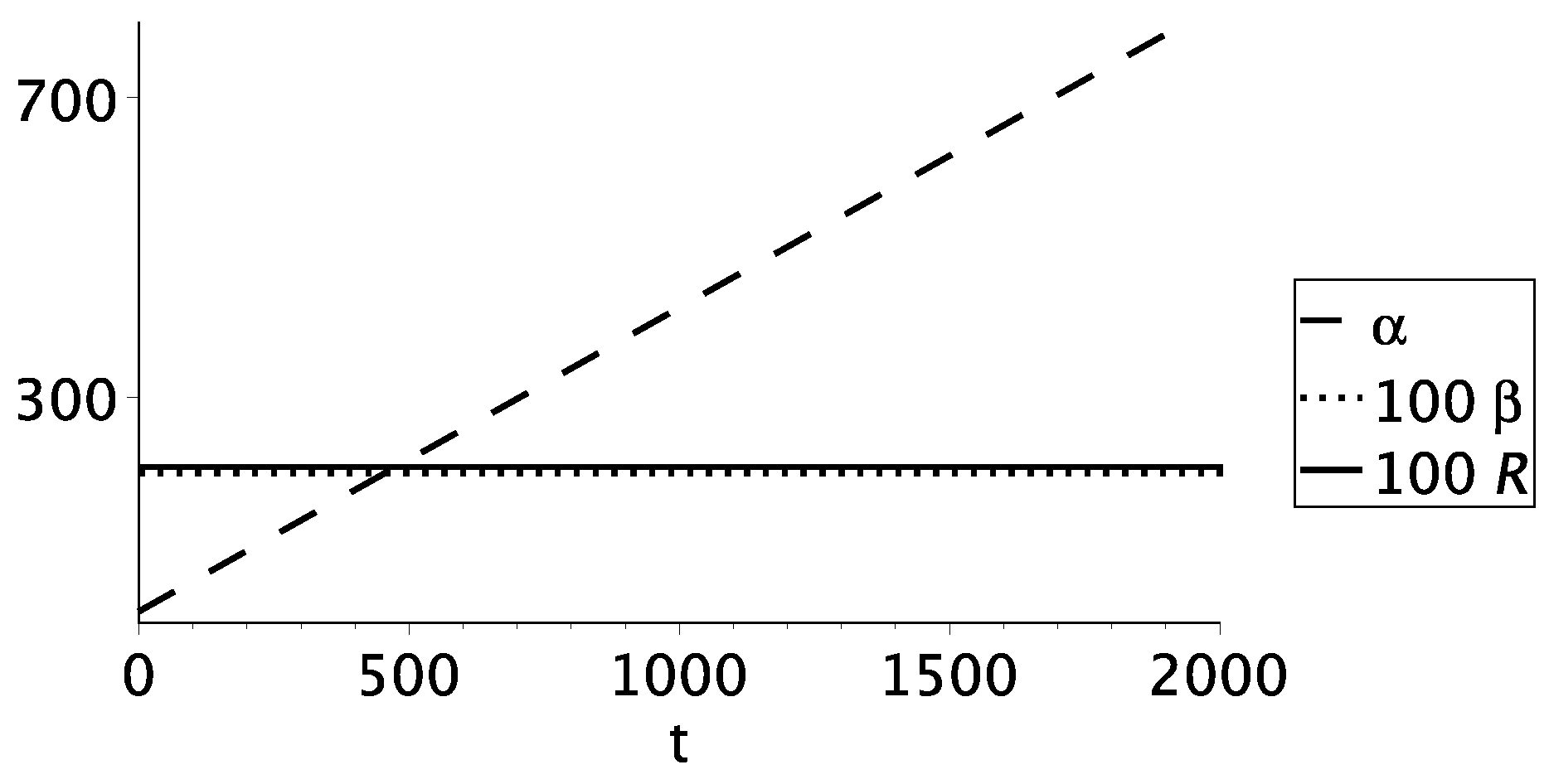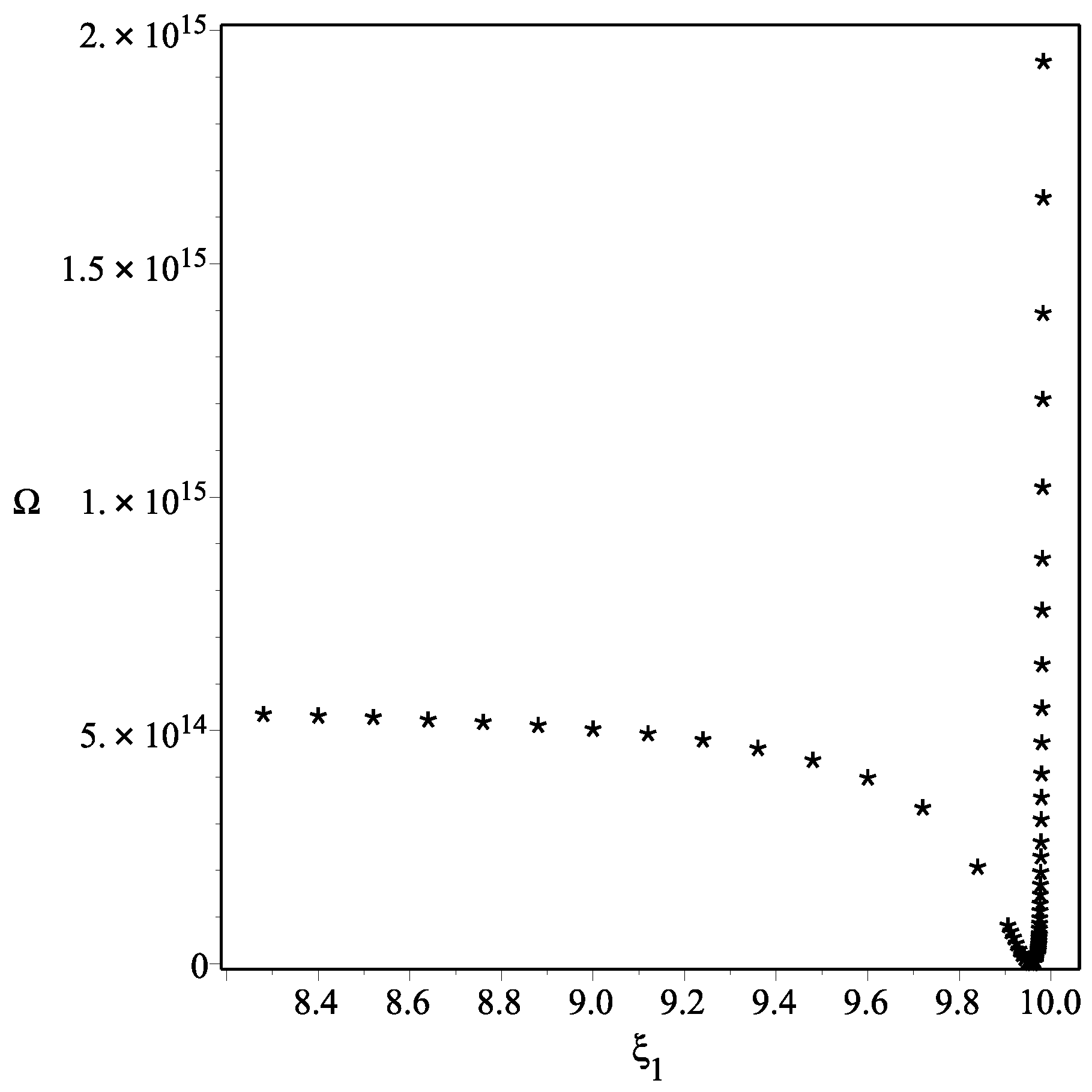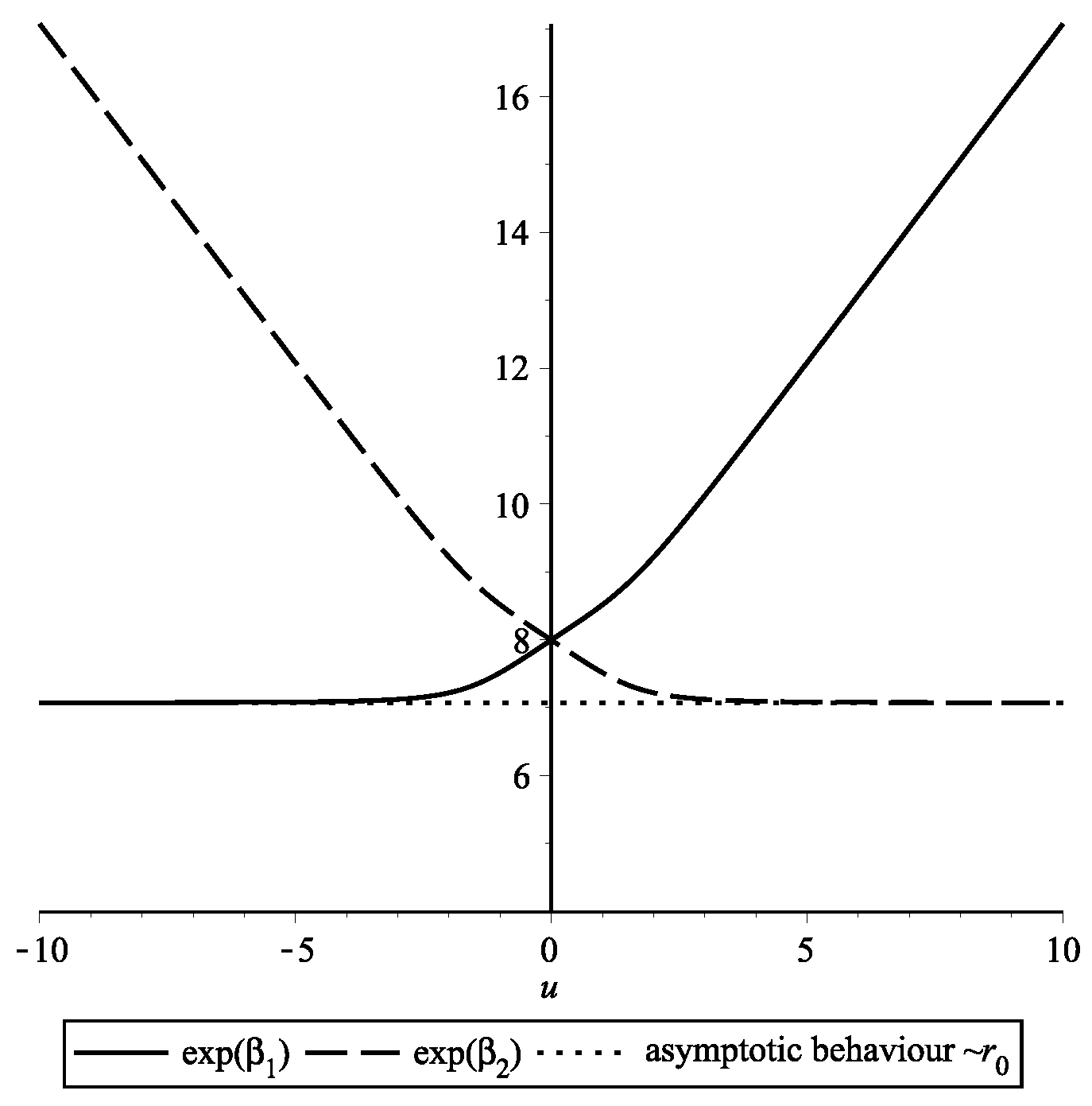Gravity with Higher Derivatives in D-Dimensions
Abstract
1. Introduction
- Reduction of action to the scalar tensor gravity. This way is effective for the action in the form
- Direct solution to equations of motion.
- Derivation of approximate equations provided that a system contains a small parameter.
- Method of trial functions.
2. Reduction of Action to the Scalar-Tensor Gravity
2.1. Conformal Transformations in D Dimensions
2.2. The Starobinsky Model
3. Direct Solution to Equations of Motion
- gravity,
- + Gauss–Bonnet gravity.
3.1. Gravity
3.2. Starobinsky Model, Direct Calculation
3.3. + Gauss–Bonnet Gravity
4. Approximate Method
4.1. Basic Idea
4.2. Extension of the Model: Low Energies
4.3. Extension of the Model: Moderate Energies
5. Method of Trial Functions
6. Conclusions
Author Contributions
Funding
Conflicts of Interest
References
- Barrow, J.D.; Cotsakis, S. Inflation and the conformal structure of higher-order gravity theories. Phys. Lett. B 1988, 214, 515–518. [Google Scholar] [CrossRef]
- Woodard, R.P. The Theorem of Ostrogradsky. arXiv 2015, arXiv:1506.02210. [Google Scholar]
- Paul, B. Removing the Ostrogradski ghost from degenerate gravity theories. Phys. Rev. D 2017, 96, 044035. [Google Scholar] [CrossRef]
- De Felice, A.; Tsujikawa, S. f(R) theories. Living Rev. Relativ. 2010, 13, 3. [Google Scholar] [CrossRef] [PubMed]
- Capozziello, S.; de Laurentis, M. Extended Theories of Gravity. Phys. Rep. 2011, 509, 167–321. [Google Scholar] [CrossRef]
- Günther, U.; Moniz, P.; Zhuk, A. Multidimensional Cosmology and Asymptotical AdS. Astrophys. Space Sci. 2003, 283, 679–684. [Google Scholar] [CrossRef]
- Saidov, T.; Zhuk, A. AdS nonlinear multidimensional (D = 8) gravitational models with stabilized extra dimensions. Gravit. Cosmol. 2006, 12, 253–261. [Google Scholar]
- Saidov, T.; Zhuk, A. A nonlinear multidimensional gravitational model R+R-1 with form fields and stabilized extra dimensions. Astron. Astrophys. Trans. 2006, 25, 447–453. [Google Scholar] [CrossRef]
- Abbott, R.B.; Barr, S.M.; Ellis, S.D. Kaluza-Klein Cosmologies and Inflation. Phys. Rev. 1984, D30, 720. [Google Scholar] [CrossRef]
- Firouzjahi, H.; Sarangi, S.; Tye, S.H.H. Spontaneous creation of inflationary universes and the cosmic landscape. JHEP 2004, 09, 60. [Google Scholar] [CrossRef][Green Version]
- Antusch, S.; Dutta, K.; Halter, S. Combining High-scale Inflation with Low-energy SUSY. JHEP 2012, 3, 105. [Google Scholar] [CrossRef][Green Version]
- Khlopov, M.Y.; Rubin, S.G.; Sakharov, A.S. Primordial structure of massive black hole clusters. Astropart. Phys. 2005, 23, 265–277. [Google Scholar] [CrossRef]
- Dolgov, A.D.; Kawasaki, M.; Kevlishvili, N. Inhomogeneous baryogenesis, cosmic antimatter, and dark matter. Nucl. Phys. B 2009, 807, 229–250. [Google Scholar] [CrossRef]
- Gani, V.A.; Dmitriev, A.E.; Rubin, S.G. Deformed compact extra space as dark matter candidate. Int. J. Mod. Phys. 2015, D24, 1545001. [Google Scholar] [CrossRef]
- Dolgov, A.; Freese, K.; Rangarajan, R.; Srednicki, M. Baryogenesis during reheating in natural inflation and comments on spontaneous baryogenesis. Phys. Rev. D 1997, 56, 6155–6165. [Google Scholar] [CrossRef]
- Cline, J.M. TASI Lectures on Early Universe Cosmology: Inflation, Baryogenesis and Dark Matter. PoS 2019, TASI2018, 1. [Google Scholar]
- Ade, P.A.; Aghanim, N.; Armitage-Caplan, C.; Arnaud, M.; Ashdown, M.; Atrio-Barandela, F.; Aumont, J.; Baccigalupi, C.; Banday, A.J.; Barreiro, R.B.; et al. Planck 2013 results. XXII. Constraints on inflation. Astron. Astrophys. 2014, 571, A22. [Google Scholar] [CrossRef]
- Starobinsky, A.A. A New Type of Isotropic Cosmological Models Without Singularity. Phys. Lett. 1980, B91, 99–102. [Google Scholar] [CrossRef]
- Bamba, K.; Makarenko, A.N.; Myagky, A.N.; Nojiri, S.; Odintsov, S.D. Bounce cosmology from F(R) gravity and F(R) bigravity. J. Cosmol. Astropart. Phys. 2014, 1, 8. [Google Scholar] [CrossRef]
- Nojiri, S.; Odintsov, S.D.; Tretyakov, P.V. Dark energy from modified F(R)-scalar-Gauss Bonnet gravity. Phys. Lett. B 2007, 651, 224–231. [Google Scholar] [CrossRef]
- Sokolowski, L.M. Metric gravity theories and cosmology:II. Stability of a ground state in f(R) theories. Class. Quant. Grav. 2007, 24, 3713–3734. [Google Scholar] [CrossRef][Green Version]
- Bronnikov, K.A.; Melnikov, V.N. Conformal Frames and D-Dimensional Gravity. In The Gravitational Constant: Generalized Gravitational Theories and Experiments; NATO Science Series (Series II: Mathematics, Physics and Chemistry); de Sabbata, V., Gillies, G.T., Melnikov, V.N., Eds.; Springer: Dordrecht, The Netherlands, 2004; Volume 141. [Google Scholar] [CrossRef][Green Version]
- Faraoni, V.; Gunzig, E.; Nardone, P. Conformal transformations in classical gravitational theories and in cosmology. Fundam. Cosm. Phys. 1999, 20, 121–175. [Google Scholar]
- Blanco-Pillado, J.J.; Burgess, C.P.; Cline, J.M.; Escoda, C.; Gomez-Reino, M.; Kallosh, R.; Linde, A.; Quevedo, F. Racetrack Inflation. J. High Energ. Phys. 2004, 11, 63. [Google Scholar] [CrossRef]
- Kirillov, A.A.; Korotkevich, A.A.; Rubin, S.G. Emergence of symmetries. Phys. Lett. 2012, B718, 237–240. [Google Scholar] [CrossRef]
- Burgess, C.P. An Introduction to Effective Field Theory. Annu. Rev. Nucl. Part. Sci. 2007, 57, 329–362. [Google Scholar] [CrossRef]
- Bronnikov, K.A.; Rubin, S.G. Self-stabilization of extra dimensions. Phys. Rev. 2006, D73, 124019. [Google Scholar] [CrossRef]
- Donoghue, J.F. General relativity as an effective field theory: The leading quantum corrections. Phys. Rev. 1994, D50, 3874–3888. [Google Scholar] [CrossRef]
- Bronnikov, K.A.; Konoplich, R.V.; Rubin, S.G. The diversity of universes created by pure gravity. Class. Quant. Grav. 2007, 24, 1261–1277. [Google Scholar] [CrossRef]
- Bronnikov, K.; Rubin, S.; Svadkovsky, I. Multidimensional world, inflation and modern acceleration. Phys. Rev. D 2010, 81, 084010. [Google Scholar] [CrossRef]
- Fabris, J.C.; Popov, A.A.; Rubin, S.G. Multidimensional gravity with higher derivatives and inflation. Phys. Lett. B 2020, 806, 135458. [Google Scholar] [CrossRef]
- Shinkai, H.A. Truncated post-Newtonian neutron star model. Phys. Rev. D 1999, 60, 067504. [Google Scholar] [CrossRef]
- Boehmer, C.; Harko, T. Dynamical instability of fluid spheres in the presence of a cosmological constant. Phys. Rev. D 2005, 71, 084026. [Google Scholar] [CrossRef]
- Rubin, S.G. Interpenetrating subspaces as a funnel to extra space. Phys. Lett. B 2016, 759, 622–625. [Google Scholar] [CrossRef]
- Lyakhova, Y.; Popov, A.A.; Rubin, S.G. Classical evolution of subspaces. Eur. Phys. J. 2018, C78, 764. [Google Scholar] [CrossRef]
- Gander, M.J.; Wanner, G. From Euler, Ritz, and Galerkin to Modern Computing. SIAM Rev. 2012, 54, 627–666. [Google Scholar] [CrossRef]







Publisher’s Note: MDPI stays neutral with regard to jurisdictional claims in published maps and institutional affiliations. |
© 2020 by the authors. Licensee MDPI, Basel, Switzerland. This article is an open access article distributed under the terms and conditions of the Creative Commons Attribution (CC BY) license (http://creativecommons.org/licenses/by/4.0/).
Share and Cite
Rubin, S.G.; Popov, A.; Petriakova, P.M. Gravity with Higher Derivatives in D-Dimensions. Universe 2020, 6, 187. https://doi.org/10.3390/universe6100187
Rubin SG, Popov A, Petriakova PM. Gravity with Higher Derivatives in D-Dimensions. Universe. 2020; 6(10):187. https://doi.org/10.3390/universe6100187
Chicago/Turabian StyleRubin, Sergey G., Arkadiy Popov, and Polina M. Petriakova. 2020. "Gravity with Higher Derivatives in D-Dimensions" Universe 6, no. 10: 187. https://doi.org/10.3390/universe6100187
APA StyleRubin, S. G., Popov, A., & Petriakova, P. M. (2020). Gravity with Higher Derivatives in D-Dimensions. Universe, 6(10), 187. https://doi.org/10.3390/universe6100187







